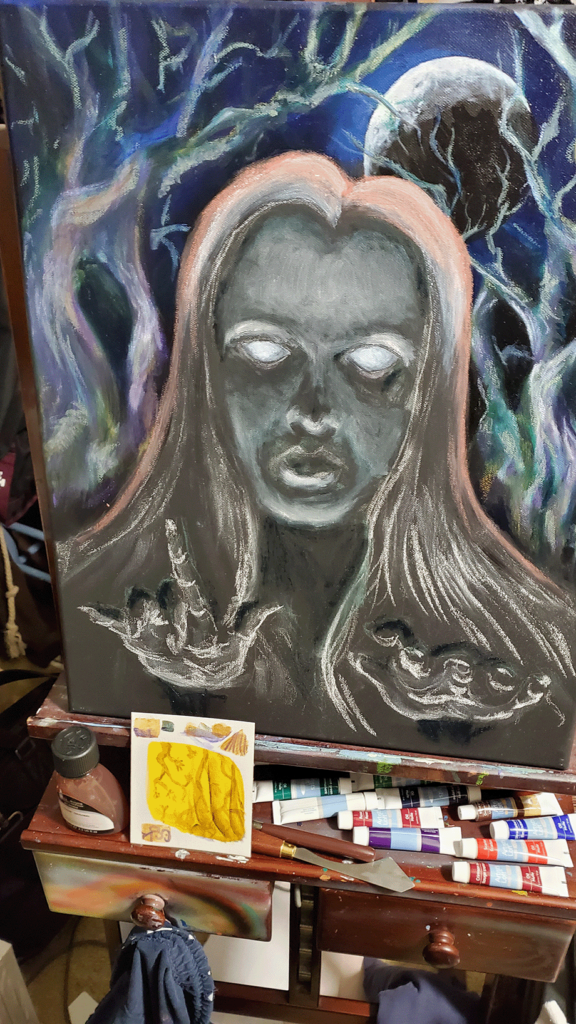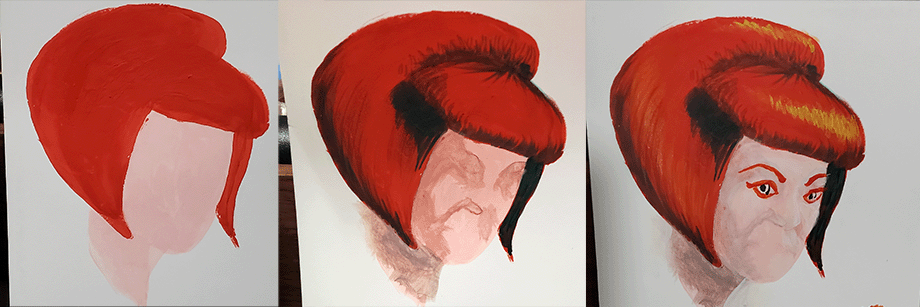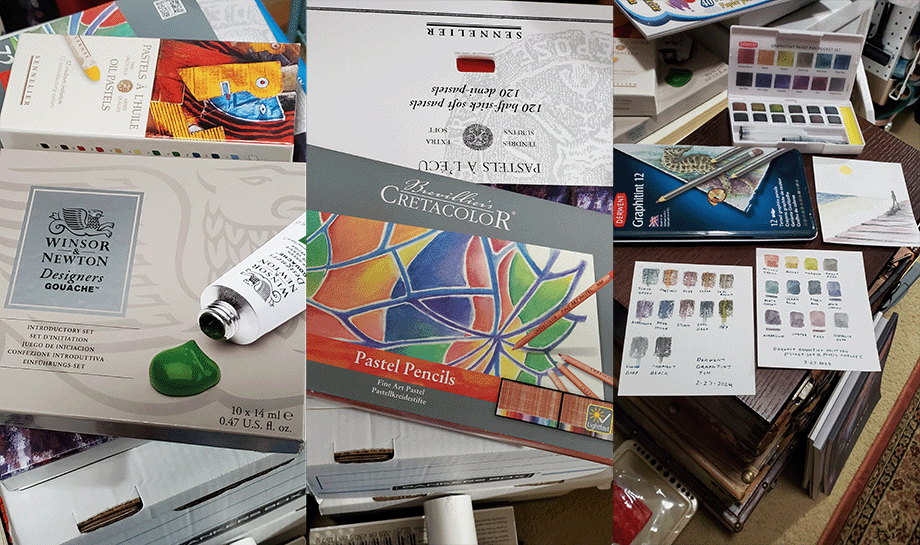One of the chief reasons for my Yuletide sabbatical was that I had not had the time in recent months to work on any of the art projects that I had planned/sketched/imagined during the several months between my last major road trip in August and the advent of my Halloween/Birthday season.
As a creature of the Winter Dark, this period is often when I circle back into myself and focus on the creative endeavors that summer obligations make difficult. Alas, as the years pass this luxury of a winter respite seems harder to return to, but in this case, the one thing I could set aside was my own commitment to a weekly article here.
I am aware my readership, while loyal, is not large. And that’s fine, because I feel like I am reaching those who are open to hearing what I am saying in the way I am saying it. I had contemplated other means of doing this, most notably a book and a podcast (not necessarily both). But the logistics of doing these to the level and extent that I envisioned them, required a great deal more of a commitment of time, at least, and energy to “make a go of it”.

So I started to put together this website with the intention of using it as a storefront, a place to sell such works as I had imagined. To compliment and enhance the branding of said wares, I started trying to put together a page or two on my personal perspective of magic and how it relates to my art. But as technical issues delayed the storefront, and I was working out options (and budget) to move the site to a new service provider that would support the storefront technology reliably, I started working with this WordPress side-site to help better articulate that message of magic and art.
I have mentioned that somewhere along the way the tail started wagging the dog. In mid December, I decided to send the dog to obedience school, and get back to the creative art part of the thing, because, a. ) the pre-paid contract for the website was already a year in with no storefront to fund renewal; and b.) there wasn’t anything for the storefront to sell.
The last couple of months have not been as productive in that respect as I would have preferred, but I do not consider the time wasted, nor do I feel that the directions I am heading in now are un-useful.
Sometimes we need to not just go back to the well, but back to the basics.
A consequence of taking a break is that my brain was somewhat more rested. Thus, said brain returned to it’s proper job of producing new ideas, resulting in a number of ideas for artwork. This was the intended purpose of taking the break. However, the new ideas brought with them a desire to use materials and methods that I had not used for some time, or never, or never together, and well, I was not at all sure I would be able to execute on the ideas offered by the now properly operating brain.
If you are a creative person, you may have had that experience of attempting to make something you can clearly see in your mind, but can’t seem to get right. It’s frustrating to the nth degree, and also, the anxiety of having such a failure can paralyze one to trying in the first place.
In fairness, after almost 40 years as a working artist, I am reasonably skilled at making my hands behave. Absent the occasional arthritic twinge, expressing visually what I see in my head is not so difficult as it used to be.
Except in the case of doing so with materials and methods that I had not used in ages, or ever, or ever together. That’s reasonable. One should not expect to execute flawlessly in a new media, or an old one that was never as friendly. And yet, the desire is there to do so. Especially if the end result is expected to be a commercial success.
Thus one is required to practice. To test, rehearse, fail, rethink, retry, and otherwise make those inevitable mistakes without the final piece being subject to these errors.
Thing is, the art of practice is not as easy as you think. Especially for a creative sort, who is expecting high quality outcomes.

That is a valid method. Essentially gouache and watercolor are the same thing- pigment with a gum arabic binder. Gouache has additional “whiting” or “body” to make them go on opaque. Unlike acrylic paint, which has largely replaced gouache in professional illustration work, the older medium will soften, melt, run, and blend even after the initial layer dries. This can be a disadvantage, or it can be useful to lighten or blend out a heavier color, as in the face above. Finessing these qualities is difficult, particularly if one doesn’t frequently use the medium.
It’s fortunate that as I am in my late 50s I have acquired the patience I did not have in my 20s. In my 20s, I worked without regard to error, in a mad blind rush of ego and drive that merely put imperfect or less successful works under the bed or in the closet to be forgotten. I had no time for specific tried methodologies of testing and practicing.
So now, I have come round full circle to making tests, to establish how the media will work for my intended final piece, indeed, whether or not it will work. In some cases, I have taken out a particular type of tool purely to practice, knowing it might not be suitable for the thing I am trying to do.
For example, I had an idea for a painting. I sketched it with oil pastel, though I knew the oil pastel wouldn’t actually give me a good result. It was not the best option to do the sketch, but I wanted to get a better feel for the oil pastels.
In another case, I sketched the idea with Conté crayon, because I had not used them in some years. The result was not a good one, but at least my hands now “remembered” how these performed. I made a very small (mind you I used to paint 4 feet canvases and larger murals) partial painting on paper using gouache, a kind of opaque watercolor. It was frustrating in ways, but also interesting to work with. I then did a second test related to the image with oil paint on paper, in order to test a metallic oil color, and a glazing medium, both of which are “new technology” since I last used oils. This also resulted in a mix of joy and disappointment.
Yet, it is the ultimate outcome of learning mastery, and understanding better, the materials which are new to me, or that I have forgotten.
Coincident with these practical exercises has been extensive research into both the direct use of these materials, but also into the proper curation of finished works using them.
For a good deal of my career, I have worked with modern acrylic paints, plain old graphite pencils, and a particular brand of colored pencils. I had academic experience with pastels, oil paint, Conté, charcoal, and water colors, as well as printmaking of various kinds and photography.
Many of these latter media are “fussy”. They can be complicated exercises in alchemy, such as oil painting, printmaking, and analog chemical photography, or simply just rather difficult to use, preserve, and store, such as pastel, water color, and charcoal drawings. In my 20s, short on patience and high on passion, it was all to easy to set these to the side, and assure myself that the “new media” of polymer emulsion acrylic paint was the way to go. “Plastic” paint would last for ages, even without a layer of polymer varnish (also easy to apply and clean up versus oil paint) and the pencil stuff was safe with enough spray on fixative.
Almost 40 years on, the implications of a petrochemical based art media is something I have more concerns about. While certainly there are pigments in use in all media that are derived from chemical sources, rare earths, and potentially toxic materials, older methods, like oil painting, watercolor, and pastels, are typically more sustainable and earth friendly.

Perhaps of most concern though as I get older is that the better quality materials may be less toxic, or at least are formulated with an awareness that the artist wants materials that are safe and renewable, and will pay a premium for it.
The most toxic solvent generally used with oil paint is turpentine, which is a by product of pine trees. Oddly enough, a number of professional paint companies have shifted to an “odorless mineral spirit” which is petroleum based. Neither is something you need to be breathing in close quarters. Both are volatile and flammable. Turpentine at least is renewable. Manufacturers are working with citrus based solvents that have the same effective properties, but are renewable, non-toxic, and no-flammable, so there is an awareness in the professional art industry that these things are an issue.
Likewise, manufacturers of pencils, crayons, and pastels are now producing vegan friendly solutions, These remove the beeswax that has been a feature of paint binders since ancient Egypt. In some media, eggs, animal glues, and other such by-products are being reconsidered in light of animal cruelty. Unfortunately, the alternative product is often a petrochemical, such as a paraben or an epoxy.
Hopefully research will yield solutions that meet both the ethical considerations and provide sustainable archival media that will allow today’s artists to be seen and appreciated in the museums of the 26th century, as we now can look at the works of the great Renaissance masters. Ironically, the late 19th and 20th century “modern” media are often the more problematic for curators. The materials themselves being made to a “commodity grade” standard, and applied, frequently, without the care and diligence that the artists of earlier eras learned through long apprenticeships.
While clearly I am writing about my recent studio work, my brain was not without the appreciation of the parallels to magical practice. During the last week I was also interviewed by Your Average Witch Podcast, and part of the discussion is always about methods of practice. It occurred to me that my approach to magic, like my approach to art, might benefit from a reacquaintance with those first principles. That is, while there are a number of things I do as habit, it couldn’t hurt to at least dig into the underlying principles behind those habits, and see if perhaps, in habitualizing them, I had shortcut some of the needed structure for the sake of convenience and time.
Like the painting, if I am doing something familiar, my hands know the way. The results are sufficient, but perhaps not spectacular. Such complacency is not beneficial. It leads to the trap of excusing poor performance, when paying closer attention, taking the time, and doing the research, might in fact have yielded a better result. And in fact the additional effort to get that first result invigorates and educates all subsequent attempts.
If I do a lot of the fiddly stuff for one or two paintings, then the next 10 or 20 paintings benefit from what I have learned, and also from the better habits of practice and research.
The same applies to spell craft and any other magical disciplines.
When we are young, we rush by what we need to do because we are in a hurry to get something done.
When we are older, we shortcut what we need to do because it doesn’t seem to make a difference.
And that’s because we didn’t do it when we were younger and didn’t have the basic sense to realize we were wrong.
Slow down. Take a breath. Re-read that chapter.
Not everything has to be a finished work. It’s okay to do something just to figure out how to do it. And to absolutely flop doing it until you figure it out.
I’ll be back in a week, I think. I have no idea what we’ll be getting into then.

